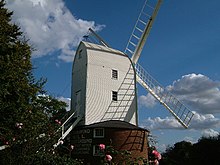Braintree (Essex)
Coordinates: 51 ° 53 ' N , 0 ° 33' E
Braintree is a middle town of approximately 42,000 people in Essex , England . It is the capital of the Braintree district .
history

The origin of the name of Braintree is disputed; some historians believe that the city was named after the Brain River ; others believe that it was exactly the other way around.
Braintree's history began about 4,000 years ago with the first settlements near the Brain River in an area now known as Skitt Hill. In addition, settlements emerged where the A120 expressway and the north-south route from London to the east coast intersect today .
It was the thoroughfare that made Braintree and its neighboring area of Bocking grow into a small town. Pilgrims on their way to Walsingham and Bury St. Edmunds traversed the region and settled in the town's thriving inns on their journey. In 1199 the Bishop of London read out a charter to establish a market place in the center of the city. The city now had the right to hold a weekly market, which attracted traders from all over the region and made Braintree the most economically important community in the area.
Flemish Protestant immigrants brought the art of wool processing to the city in the 16th century. The formerly popular inns have been converted into lucrative spinning mills. The local wool processing made the city known nationwide and brought its wealth.
When religious intolerance and financial hardship became increasingly common in the 17th century, many people in Essex, including a group from Braintree, decided to relocate to the New World. In 1632 they sailed to America on the "Lyon" and founded two new towns there called Braintree, Massachusetts and Hartford, Connecticut.
Just a few years later, the population of Braintree also suffered from the great plague of 1665 , which reduced the population by 865 to 2,300 people. But thanks to the success of the wool industry, Braintree was able to stabilize economically and grew steadily into the 19th century.
In the 19th century, wool processing was replaced by the silk industry. George Courtauld founded the first silk factory in 1908, which began the era of industrialization in the city. In 1880 - with a total population of 8,500 inhabitants - 1,300 mostly female wage workers worked in the textile factory.
With a flourishing agriculture, the construction of a grain exchange in 1839 and the construction of a rail link in 1848, Braintree grew into an economically attractive area. Attracted by the economic boom, Warner & Son was founded in 1895, a smaller company specializing in handcrafted wool products. In addition to wealthy commoners, his customers also included the royal family of England. Memories of that time can still be inspected in the Warners Textile Museum today.
At the beginning of the 20th century, the metal industry also began to expand locally. The company Critalls, specializing in the manufacture of metal-framed windows, developed into one of the largest of its kind in the world. Another example of Braintree's success is the Lake & Elliot foundry (1896), which grew from a bicycle accessories distributor to a wealthy large-scale foundry.
The metal industry dominated Braintree's economy well into the 20th century. The city supplied the British Army with ammunition during World War II. With the end of World War II, the Braintree metal industry era also came to an end.
The city still benefits from the prosperous times of the textile industry. Numerous buildings erected by the Courtauld family adorn the old town. Among them are the town hall, the old school, which is now used as a museum, the hospital and the city garden, which Sydney Courtauld had built in 1888.
geography
Braintree is located in North Essex about 60 km from London. It is 46 m above sea level. Two rivers flow through Braintree: "Pods Brook" rises in the west of the city and forms a natural border between Braintree and the neighboring village of Rayne; in Braintree it then becomes the river “Brain”. The river "Pant" (or Blackwater) runs through the north of Bocking (Essex) and leaves the city in the east. The River Brain eventually flows into the Blackwater near Witham.
traffic
Braintree has two train stations (Braintree City and Freeport) with hourly train connections to / from London and Colchester respectively. Only bus routes lead to Nordessex. The Colne Valley railway line was discontinued and dismantled in 1963; today there is only a short museum railway line with steam locomotive operation.
sons and daughters of the town
- Liam Howlett: founder of the band The Prodigy
literature
- Braintree Town Center Strategy Group, 2004
- http://georgeyard.co.uk/pdf/braintree_history.pdf

